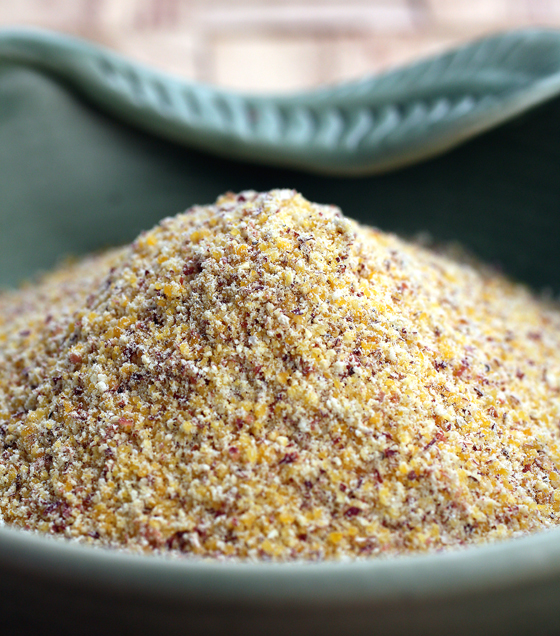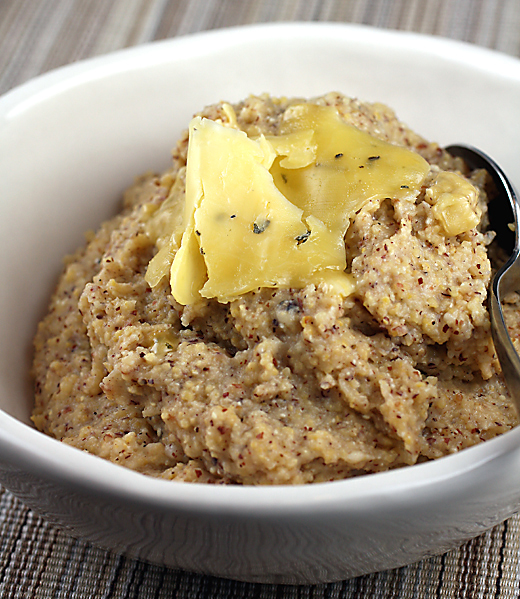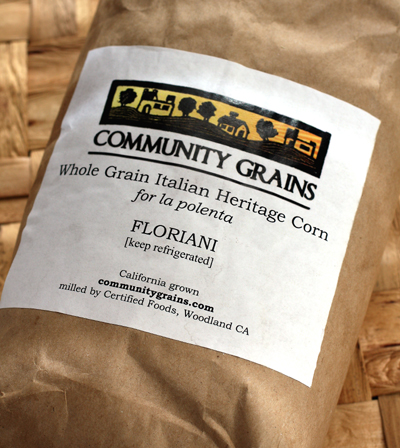Three-Hour Polenta
You might think I’m playing an April Fool’s joke on you when I tell you I spent three hours cooking polenta on the stovetop.
But I kid you not.
That was part of the careful cooking instructions I was given when Oliveto Restaurant in Oakland gave me a sample bag of Floriani Red Flint Corn Polenta to try at home. The medium-course grind polenta is made from heritage red field corn that was originally developed in Northern Italy. It is whole-grain milled, meaning that the entire grain — including all the germ, bran and endosperm — is milled without separating any of those components out.
Because of that and because it’s a harder corn, it takes three hours to cook.
I was ready to start lifting more weights at the gym for this polenta workout that awaited me. My husband half-jested that he was going to hire a legal day-laborer to help me.
Fortunately, Oliveto Owner Bob Klein reassured me that this polenta did not take continuous stirring at the stove for all three hours. He said an occasional go-round with a wooden spoon would be just fine.
Whew!
Oliveto has long championed local, artisanal products. That interest led the restaurant to start trying to source locally milled flours and other grains for its housemade pastas. The result was the creation of Community Grains, begun by Oliveto and Certified Foods of Woodland, Calif., which has started working with farms to grow heritage Italian and rare California wheat varieties.
The Floriani Red Flint Corn Polenta is now available for purchase at Oliveto for $24 for a three-pound bag.
The first thing you notice when you open the bag is that this polenta is not uniformly bright golden yellow like others. Instead, it’s got flecks of yellow, but also red, white, sand and deep brown.
When cooking, use a ratio of about 1 cup of the polenta to 4 cups of water or stock. And be sure to use a heavy-duty, well-insulated pot so that the polenta doesn’t burn on the bottom.
Just a minute after pouring the polenta into the pot of simmering liquid, the mixture will thicken up fast. Keep it on a gentle simmer, giving it a stir every 20 minutes or so. If it starts to thicken up too much to your liking, just stir in a little more liquid.
As the hours tick by, the polenta will get more and more creamy in consistency.
Just before serving, stir in a little butter and grated cheese, if you like.
The polenta will be quite thick, almost porridge-like. But take a taste and you’ll find it surprisingly light and rather fluffy, as opposed to dense and heavy. The flavor is wonderfully nutty and hearty.
I served it as a bed for beef stew. But I can imagine it also being fabulous for breakfast with maple syrup or brown sugar.
I’ll just have to set my alarm clock super early, though, to have any chance of making it before lunch hits.






That polenta is beautiful and must taste wonderful! Wow, that takes time…
Cheers,
Rosa
I’m sure it was worth the wait!
Pingback: Food Gal » Blog Archiv » Oliveto Keeps On Going Strong
I’ve learnt something new again! Luckily you didn’t have to continuously stir the pot for 3 hours 😀 The polenta looks gorgeous though and I’m sure was worth the wait.
After reacqainting myself with quinoa, and finding a vibrant red royal variety, I am loving the look of your polenta find. I’m heading over to check out Community Grains right now!
Corn is one of my all time favorite grains(?) vegetables?(?) and polenta is something I haven’t tried making but love to get at restaurants.
I’m intrigued by this polenta – such unique colors! I love the idea that it includes the germ, bran, endosperm . . all the healthy stuff!
Carolyn, what did you do with the left overs? How much did you use and did you use water or stock with it? It looks very interesting!
What gorgeous colors. I wonder if you can make a firmer version to pan fry it for a crispy texture.
Do you think you could make this in a slow cooker or a fuzzy logic rice cooker on porridge setting? I love using those appliances for long cooked things because the heat control is so stable and no more soaking and scraping pan bottoms.
Karen Tran: I be you could use a slow cooker of fuzzy logic rice cooker to make this. Would be a great way to not have to watch it so closely on the stove, too. One of my friends uses her slow cooker for polenta all the time.
Tami: I often crisp up leftover polenta in cake-form the next day. I bet it would work well with this polenta, too.
Sharon: I used chicken stock to cook my polenta. But you could use water instead if you prefer.
Wow, three hours! Amazing! It sure does not look like a regular polenta, I bet it’s fantastic, would love to try!
Wow, I have never heard of such a thing! But it looks like it was all worth the effort, I bet it tasted amazing too!
I like Karen’s idea for using a fuzzy logic rice cooker for this. You’re a brave woman Carolyn to stick near the stove for three hours!
L
I’d love to make polenta and parmesan chips out of this! Unfortunately I’ve never seen anything like that in these parts, but I’ll keep looking 🙂
WOW! That looks great! I keep hearing about all the heirloom grains. I really need to get with it and try some out. Love the melted cheese on top. YUM YUM!! 🙂
it looks wonderful & surely worth the wait !!
Wow 3 whole hours of labour must’ve made this dish so yummy! I’ve yet to give ordinary polenta a try, looks like I’ll start with the easy ones first 🙂
Wow, now I feel like a polenta hack. I made it last night for a dinner party and only spent 15 or 20 minutes. I love all the colors in yours. It really puts the “art” in artisanal!
Lentil Breakdown: LOL That sounds like the Rachael Ray 30-Minute version. You can probably get away with cooking the polenta for less than three hours. But the texture does get creamier the longer you cook it. If you like a more coarse texture, though, by all means, enjoy it that way.
3 hrs!?!? No joke. But glad it was not constant stirring for 3 hrs :0
It happens that I just cooked polenta (or is it cornmeal?) over the weekend like a gruel a.k.a porridge. I had to keep on stirring though to prevent lumping! 🙁
3 hr polenta – impressive!
I’ve never come across polenta that takes 3 hours to cook but thank goodness it didn’t require constant stirring. Now that would be a test of patience!
whole grain polenta looks amazing–i’ve never seen it before! i’m not known for my patience, but some things are just worth it.
I adore polenta and I must admit that this three-hour polenta looks gorgeous and so flavorful! It really does look like it has a nuttier flavor than regular yellow polenta. I would definitely try it!
Oh my, can I use the pressure cooker? hehe
Wow now that’s dedication but I bet the creamy texture was awesome!
oh wow i would love to try that. it looks wonderful!
Mmm, I love creamy polenta. One of my ultimate comfort foods!
Carolyn, Do you know if I can get this in NYC?
Dina: I don’t think you can get it in New York. Right now, it’s only available for purchase at Oliveto Restaurant in Oakland. However, Community Grains hopes to start selling it on its Web site in the near future. So, stay tuned.
My name is Silvano Floriani. I live in Pergine, province of Trento, Italy. I am the father of Marco Floriani, a friend of William Rubel, who was a guest at my house and on that occasion tasted the polenta made with the flour corn I grow. I gave William some seeds to try sowing this corn in America. Recently William pointed my attention to some web sites that show how successful the experiment was, and that this corn is now grown in several places in North America, known as “Floriani Red Flint”. This way the surname of my family became famous in America, without any merit of mine. Now, I read on this blog that it takes three hours to cook polenta. This is usually not true! We always cooked polenta in about 40 minutes, in a heavy copper pot (cauldron?), placed over a strong enough fire, stirring every minute. I hope you can enjoy lots of Floriani polentas, in the years to come, and I send you my cordial greetings!
Carolyn: Delighted to find your post as I have some of that magnificent Floriani polenta bubbling on the back burner as I write.
Even more exciting was to see Silvano Floriani’s post, which not only gives the polenta an extra sense of place and a personal note, but also because I was curious about what happens to change the polenta between the first hour or so, when presumably it would be cooked through, and the recommended 3 hours.
I have mine cooking in water with a splash of whole milk, a drizzle of maple syrup, and a good pinch of salt. It may be lunch time when it’s ready, but I’m callin’ it breakfast!
Grazie e tanti auguri a lei e alla sua famiglia, Signore Floriani!!
Grazie Signore Floriana e Carolyn Jung –
Thank you for your blog and for introducing the marvelous polenta to us in the US. I ate this first at Oliveto and ordered some to try at home (Dallas TX). The three hour time on the package was a surprise – mine was delicious in 45 minutes or so.
Wondering how you can cook it three hours without burning. I have a nice heavy bottom Demeyere pot but it would never have survived three hours. Thanks for any advice – if the longer cooking is a good idea I would like to try it – but need help.
Barbara: You can definitely eat it after cooking it for only 45 minutes. If you cook it longer, it just gets creamier in consistency. I use a heavy-bottom pan on a low flame, and I try to stir it every 20 minutes or so when I cook it for three hours. Even if the very bottom sticks a little, the rest of it is good to go for you to enjoy. 😉
Pingback: Polenta + Roasted Persimmons | Beyond [the Plate]
Looks like you figured it out first. Nice article.
Saw it because I couldn’t find Bill’s book.
Wikepedia:
In his book Heat, Bill Buford talks about his experiences as a line cook in Mario Batali’s Italian restaurant Babbo. Buford details the differences in taste between instant polenta and slow-cooked polenta, and describes a method of preparation that takes up to three hours, but does not require constant stirring: “polenta, for most of its cooking, is left unattended…. If you don’t have to stir it all the time, you can cook it for hours—what does it matter, as long as you’re nearby?”
Batali now uses instant polenta in his recipes.
I’ve ground my corn fine and made it that way. Insipid taste, just like instant oatmeal which should be steel cut coarse and soaked overnight.
Here is a method I have used that gives wonderful results.
https://www.finecooking.com/recipe/shortcut-polenta
As I live in Mexico I buy various types of corn from local farmers, along with molasses, organic eggs, etc and grind it for corn bread, polenta, grits, tortillas and whatever I and my friends want. Do the same with oatmeal, spelt, millet, wheat and other grains. My Bosch Kitchen Machine is still going strong after 20+ years of daily use and needing only a new blender lid and bottom seal.
Gave up on Kitchen Aid mixers long ago as they don’t stand up and the Bosch is so much better in so many ways, though many accessories have gotten way too expensive.
Feel free to edit or delete it as I’m just a journeyman cook with old fashioned
ideas and time to prepare meals from scratch.
Pingback: 7 Northern Italian Dishes You Need To Try – Big 7 Travel
Pingback: 7 Ñтрав Північної Італії, Ñкі вам потрібно Ñпробувати – Big 7 Travel - Про ТурÐ